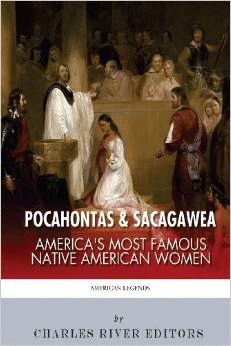Description
*Includes pictures of historic art depicting Pocahontas, Sacagawea and other important people and places.
*Discuss the legends and myths that have become part of their legacies.
*Include accounts of Pocahontas and Sacagawea written by John Smith, Lewis and Clark, and the Native Americans themselves.
*Includes bibliographies for further reading.
The life of Pocahontas fulfills a specific role in American culture and history. Her short life holds a bittersweet tragedy that is part of the mythology of Native America, especially the first encounters between English settlers and the local native tribes. The meaning of her name, “little plaything” or “little wanton,” suggests that she was destined to be bandied about by the powers in her life. The men of the time simply assumed a young Native American girl did not deserve or even want respect.
She had many other names, however, some which would have never been known to people outside her tribe, let alone European colonists. What historians do know is Pocahontas was also known as Matoaka, she was born sometime in 1595, and she was the daughter of the paramount chief (mamanatowick) Powhatan, leader of an Algonquian-speaking native group. She grew up in Tsenacommacha, the “densely inhabited Land” of eastern Virginia, where English explorers and settlers under the leadership of Lord Newport yearned to find a passage to the “other sea.” The English settlers were also ready to play the role of the legendary Spanish conquistadors and hoping to find hidden gold in the region.
Nevertheless, generations of Americans and English have been taught that Pocahontas was part of a unique fairytale, saving the life of explorer John Smith and later becoming his wife. While their relationship has been the subject of countless historical texts and even children’s books, it has no historical basis in fact. There is still even some doubt over whether she saved his life in the famous encounter that has ensured her name remains instantly recognizable nearly 400 years after her death.
Sacagawea is one of the most famous Native American women in American history, and few played such a central role in the settlement of the West for the young nation. As a young woman who was married to a French trapper from Quebec, Sacagawea happened to be in the right place at the right time for the legendary Lewis and Clark expedition, which set off for the Pacific coast after President Thomas Jefferson negotiated the Louisiana Purchase with France. The young Shoshone girl acted as a guide and interpreter for the expedition, helping it safely travel thousands of miles west from North Dakota to the Pacific over unfamiliar ground and amongst unfamiliar peoples. Put simply, the expedition could not have succeeded without her.
Sacagawea’s role in the Lewis and Clark expedition made her a national figure, and she continued to be popularized in literature and even among groups advocating for women’s rights. Sacagawea is still taught to every American in school and stands alongside Pocahontas as the most famous Native American women, even though few people knew much about her life aside from her role in the trek. For that reason, few truly know about her life, her tribe, or her death, the latter of which is still controversial. At the same time, given the history and conflicts between the United States and various Native American tribes during the 19th century, Sacagawea’s role in helping the nation push westward at the expense of Native Americans has taken on a more mixed and controversial character.
Pocahontas & Sacagawea profiles the lives and legacies of the famous Native American girls. Along with pictures of important people, places, and events, you will learn about Pocahontas & Sacagawea like never before.






Reviews
There are no reviews yet.